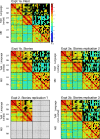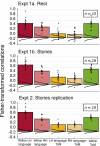Functionally distinct language and Theory of Mind networks are synchronized at rest and during language comprehension
- PMID: 30601693
- PMCID: PMC6485726
- DOI: 10.1152/jn.00619.2018
Functionally distinct language and Theory of Mind networks are synchronized at rest and during language comprehension
Abstract
Communication requires the abilities to generate and interpret utterances and to infer the beliefs, desires, and goals of others ("Theory of Mind"; ToM). These two abilities have been shown to dissociate: individuals with aphasia retain the ability to think about others' mental states; and individuals with autism are impaired in social reasoning, but their basic language processing is often intact. In line with this evidence from brain disorders, functional MRI (fMRI) studies have shown that linguistic and ToM abilities recruit distinct sets of brain regions. And yet, language is a social tool that allows us to share thoughts with one another. Thus, the language and ToM brain networks must share information despite being implemented in distinct neural circuits. Here, we investigated potential interactions between these networks during naturalistic cognition using functional correlations in fMRI. The networks were functionally defined in individual participants, in terms of preference for sentences over nonwords for language, and for belief inference over physical-event processing for ToM, with both a verbal and a nonverbal paradigm. Although, across experiments, interregion correlations within each network were higher than between-network correlations, we also observed above-baseline synchronization of blood oxygenation level-dependent signal fluctuations between the two networks during rest and story comprehension. This synchronization was functionally specific: neither network was synchronized with the executive control network (functionally defined in terms of preference for a harder over easier version of an executive task). Thus, coordination between the language and ToM networks appears to be an inherent and specific characteristic of their functional architecture. NEW & NOTEWORTHY Humans differ from nonhuman primates in their abilities to communicate linguistically and to infer others' mental states. Although linguistic and social abilities appear to be interlinked onto- and phylogenetically, they are dissociated in the adult human brain. Yet successful communication requires language and social reasoning to work in concert. Using functional MRI, we show that language regions are synchronized with social regions during rest and language comprehension, pointing to a possible mechanism for internetwork interaction.
Keywords: Theory of Mind; communication; fMRI; functional connectivity; language.
Conflict of interest statement
No conflicts of interest, financial or otherwise, are declared by the authors.
Figures










Similar articles
-
No evidence of theory of mind reasoning in the human language network.Cereb Cortex. 2023 May 9;33(10):6299-6319. doi: 10.1093/cercor/bhac505. Cereb Cortex. 2023. PMID: 36585774 Free PMC article.
-
Exploring links between language and cognition in autism spectrum disorders: Complement sentences, false belief, and executive functioning.J Commun Disord. 2015 Mar-Apr;54:15-31. doi: 10.1016/j.jcomdis.2014.12.001. Epub 2015 Jan 6. J Commun Disord. 2015. PMID: 25637130
-
Gaze patterns and brain activations in humans and marmosets in the Frith-Happé theory-of-mind animation task.Elife. 2023 Jul 14;12:e86327. doi: 10.7554/eLife.86327. Elife. 2023. PMID: 37449983 Free PMC article.
-
Theory of mind and language comprehension in schizophrenia.Psicothema. 2013;25(4):440-5. doi: 10.7334/psicothema2012.357. Psicothema. 2013. PMID: 24124775 Review.
-
Theory of mind and neurodevelopmental disorders of childhood.Pediatr Res. 2011 May;69(5 Pt 2):101R-8R. doi: 10.1203/PDR.0b013e318212c177. Pediatr Res. 2011. PMID: 21289541 Review.
Cited by
-
Precision fMRI reveals that the language-selective network supports both phrase-structure building and lexical access during language production.Cereb Cortex. 2023 Apr 4;33(8):4384-4404. doi: 10.1093/cercor/bhac350. Cereb Cortex. 2023. PMID: 36130104 Free PMC article.
-
The human language system, including its inferior frontal component in "Broca's area," does not support music perception.Cereb Cortex. 2023 Jun 8;33(12):7904-7929. doi: 10.1093/cercor/bhad087. Cereb Cortex. 2023. PMID: 37005063 Free PMC article.
-
More Than Words: Extra-Sylvian Neuroanatomic Networks Support Indirect Speech Act Comprehension and Discourse in Behavioral Variant Frontotemporal Dementia.Front Hum Neurosci. 2021 Jan 14;14:598131. doi: 10.3389/fnhum.2020.598131. eCollection 2020. Front Hum Neurosci. 2021. PMID: 33519400 Free PMC article.
-
Individual-subject Functional Localization Increases Univariate Activation but Not Multivariate Pattern Discriminability in the "Multiple-demand" Frontoparietal Network.J Cogn Neurosci. 2020 Jul;32(7):1348-1368. doi: 10.1162/jocn_a_01554. Epub 2020 Feb 28. J Cogn Neurosci. 2020. PMID: 32108555 Free PMC article.
-
Task-specific network interactions across key cognitive domains.Cereb Cortex. 2022 Nov 9;32(22):5050-5071. doi: 10.1093/cercor/bhab531. Cereb Cortex. 2022. PMID: 35158372 Free PMC article.
References
-
- Appleton M, Reddy V. Teaching three-year-olds to pass false belief tests: a conversational approach. Soc Dev 5: 275–291, 1996. doi:10.1111/j.1467-9507.1996.tb00086.x. - DOI
MeSH terms
Grants and funding
LinkOut - more resources
Full Text Sources

